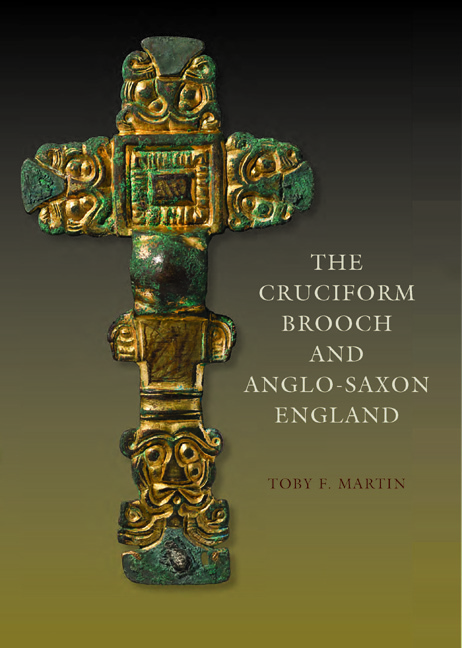Book contents
- Frontmatter
- Dedication
- Contents
- List of Illustrations
- Preface
- Acknowledgements
- 1 The Anglian Brooch par excellence
- 2 A New Typology for Cruciform Brooches
- 3 Building a Chronological Framework
- 4 Cycles of Exchange and Production
- 5 Migrants, Angles and Petty Kings
- 6 Bearers of Tradition
- 7 Cruciform Brooches, Anglo-Saxon England and Beyond
- Appendix 1 Cruciform Brooches by Type
- Appendix 2 Cruciform Brooches by Location
- Appendix 3 A Guide to Fragment Classification
- Bibliography
- Index
- Plate Section
6 - Bearers of Tradition
Published online by Cambridge University Press: 05 May 2015
- Frontmatter
- Dedication
- Contents
- List of Illustrations
- Preface
- Acknowledgements
- 1 The Anglian Brooch par excellence
- 2 A New Typology for Cruciform Brooches
- 3 Building a Chronological Framework
- 4 Cycles of Exchange and Production
- 5 Migrants, Angles and Petty Kings
- 6 Bearers of Tradition
- 7 Cruciform Brooches, Anglo-Saxon England and Beyond
- Appendix 1 Cruciform Brooches by Type
- Appendix 2 Cruciform Brooches by Location
- Appendix 3 A Guide to Fragment Classification
- Bibliography
- Index
- Plate Section
Summary
Only particular women in early Anglo-Saxon society wore cruciform brooches. Upon their death, their mourners buried or cremated many of them deliberately and spectacularly in their full regalia. In so doing, their surviving kin drew persuasive connections between their own social status and that of their deceased wife, mother, sister, daughter, cousin or more distant relative. The women who wore cruciform brooches were therefore a minority capable of standing for a greater whole. By wearing cruciform brooches in life and in death, they bore a material tradition that held considerable importance to their kin group, household or wider community. The fact this costume was part of a tradition incorporating whole swathes of Europe, from the Baltic to the Black Sea, gives lie to its significance. Selected women from these regions wore a range of elaborate bow brooches, items belonging to the same typological genus, but of species differentiated by region. While the previous chapter explored how distinctions arose between these groups, here I am going to discuss the social structures within them. Recalling also from the previous chapter the idea that identity is something people do rather than a quality they intrinsically possess, I would also like to explore the actual media through which identity was enacted, namely the body and its dress. Due to its inestimable centrality to all human experience, the body is inseparable from most aspects of identity. Hence, Anglo-Saxon society sustained internal distinction by accentuating the corporeal differences supplied by biological sex and age with different forms of dress. Not only do we therefore require demographic information concerning the sex and age of cruciform brooch wearers from the skeletal remains of their bodies, we also need to explore the promulgation of their identity through the metallic and textile remains of their costume.
To pursue these lines of enquiry, the present chapter switches focus from the abstracted concepts of typology, chronology, exchange and distribution to the tangible and corporeal environment of the early Anglo-Saxon cemetery.
- Type
- Chapter
- Information
- The Cruciform Brooch and Anglo-Saxon England , pp. 191 - 232Publisher: Boydell & BrewerPrint publication year: 2015

